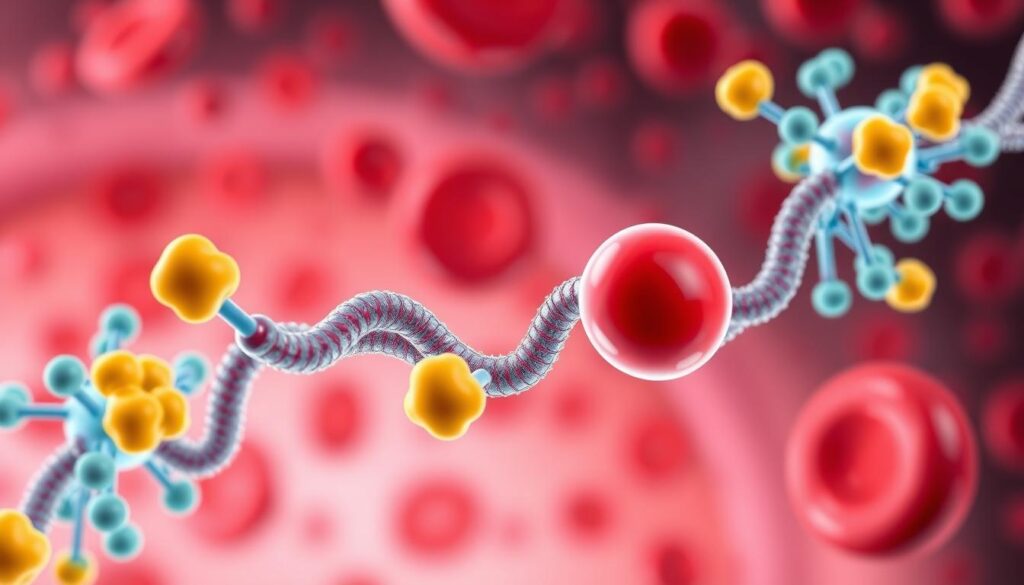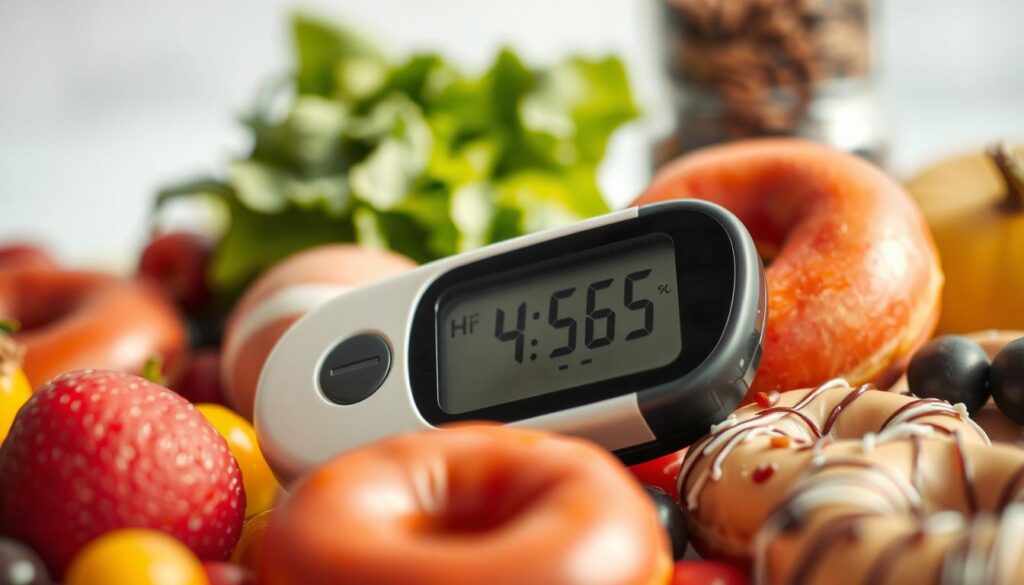Have you noticed your blood sugar levels can be high sometimes? Even when your A1C test shows normal or near-normal levels. This mix-up is common for people with diabetes or prediabetes.
It’s important to understand how A1C and blood sugar levels connect. This knowledge helps manage glucose and prevent diabetes problems. We’ll dive into the science, common reasons, and tips for better blood sugar control.
Key Takeaways
- A1C is a measure of average blood glucose levels over the past 3 months
- Normal A1C is below 5.7%, prediabetes range is 5.7-6.4%, and diabetes is 6.5% or higher
- High blood sugar levels can occur even with a normal A1C due to factors like diet, lifestyle, and medical conditions
- Monitoring blood sugar beyond just A1C tests, such as with continuous glucose monitoring, can provide a more comprehensive picture
- Lifestyle changes like diet and exercise can significantly impact blood sugar control and A1C levels
Understanding A1C and Blood Sugar Levels
The A1C test is key for managing diabetes. It shows how much glucose is attached to your red blood cells over 3 months. Knowing what A1C measures helps you control your diabetes better.
What A1C Measures in Your Body
Hemoglobin is a protein in your red blood cells. It carries oxygen. When glucose attaches to hemoglobin, it creates glycated hemoglobin, or A1C.
The more glucose in your blood, the higher your A1C level. This is because more glucose bonds to your red blood cells over 3 months.
Normal A1C Range and Blood Sugar Correlation
- Less than 5.7% A1C level indicates no diabetes.
- A1C range of 5.7% to 6.4% signals prediabetes.
- A1C of 6.5% or higher usually indicates Type 2 diabetes.
- American Diabetes Association recommends an A1C goal of 7% or lower for most adults with diabetes.
- People with Type 1 diabetes who are pregnant are recommended to aim for an A1C of 6.5% or lower.
The A1C test also shows an estimated average glucose (eAG) level. For example, an A1C of 7% means your eAG is 154 mg/dL.
The Three-Month Blood Sugar Average
The A1C test shows your blood sugar control over 3 months. It gives a long-term view, unlike daily glucose tests. This helps your doctor see how well you’re managing your diabetes.
This info is key for making treatment decisions and adjusting your diabetes plan.
“Consistently keeping A1C levels below 7% may reduce the risk of diabetes complications.”
The Science Behind High Blood Sugar But Normal A1C
It’s important to know how blood sugar and A1C levels work together. A1C shows your blood sugar over three months. But, it might not always show your daily sugar levels.
Things like hemoglobin variants and some health issues can affect A1C. Some people might have big changes in blood sugar that A1C doesn’t catch. This can happen if recent high sugars aren’t in the A1C average yet.
Studies show that A1C levels can mean different blood sugars. For example, an A1C of 6.0% might mean blood sugar is between 100 and 152 mg/dL. An A1C of 7.0% could mean it’s between 123 and 185 mg/dL. This shows why looking at both daily sugar and A1C is key for health.
| A1C Level | Mean Blood Glucose (95% CI) |
|---|---|
| 6.0% | 100-152 mg/dL |
| 7.0% | 123-185 mg/dL |
Research also shows that A1C and glucose levels can differ by race. For example, African Americans and Caucasians might see different results. Twin studies also found that A1C can run in families, showing it’s not just about diet or exercise.
Knowing how blood sugar and A1C work can help you take better care of your health. Using tools like continuous glucose monitoring (CGM) can give you more info than just A1C.
“Improved knowledge of the pathways involved in the discordance between blood glucose and HbA1c might identify mechanisms of injury amenable to intervention.”
Common Causes of Blood Sugar Spikes
Even without diabetes, blood sugar spikes happen often. They come from what we eat, how we live, and hormones. Knowing why they happen helps keep our sugar levels steady and our health good.
Dietary Factors Affecting Blood Glucose
What we eat affects our blood sugar. Foods high in carbs, like white rice and pasta, cause spikes. But, eating whole grains and veggies helps keep sugar levels stable.
Not eating breakfast or eating too often can mess with our sugar rhythm. This leads to unwanted ups and downs.
Lifestyle Influences on Blood Sugar
Our daily habits affect our blood sugar. Not moving enough and not sleeping well make it hard for our body to manage sugar. Even one bad night can hurt our insulin sensitivity.
Regular exercise, like a short walk after dinner, can help control sugar and improve insulin use.
Stress and Hormonal Impact
Stress, whether it’s physical or emotional, raises blood sugar. Hormones like cortisol and adrenaline are released. Medical issues, like Cushing’s syndrome, can also mess with our hormones and sugar levels.
Medicines, infections, and smoking can make blood sugar spikes worse. Paying attention to how our body reacts and talking to our doctor helps find and fix the problems.
“Knowing what affects blood sugar is the first step to managing it. By looking at what we eat, how we live, and our hormones, we can control our sugar levels and keep our health in check.”
How A1C Testing Works
The hemoglobin A1C test is key for checking your blood sugar over time. It shows how much sugar has stuck to your red blood cells in the last 2-3 months. You don’t need to fast for this test, and it can be done at any time.
The test shows your results as a percentage. A normal A1C level is below 5.7%. If it’s between 5.7% and 6.4%, you might have prediabetes. An A1C of 6.5% or higher on two tests means you have diabetes.
The National Glycohemoglobin Standardization Program (NGSP) makes sure A1C tests are the same everywhere. This helps doctors understand your A1C results correctly.
Point-of-care A1C tests in a doctor’s office are for checking, not for diagnosing. For a real diabetes diagnosis, you need a lab-based A1C test.
| A1C Level | Blood Sugar Range | Condition |
|---|---|---|
| Below 5.7% | Less than 126 mg/dL | Normal |
| 5.7% to 6.4% | 126 to 154 mg/dL | Prediabetes |
| 6.5% or higher | 155 mg/dL or higher | Diabetes |
Knowing how the hemoglobin A1C test works helps you work with your doctor. This way, you can keep your blood sugar in check and avoid diabetes problems.

Factors Affecting A1C Accuracy
The A1C test is key for checking blood sugar levels. But, many things can change how accurate it is. This includes health issues, medicines, and even who you are.
Medical Conditions Impact on Results
Some health problems can mess with your A1C test. For example, anemia can make your A1C look lower than it is. Also, liver or kidney disease can change your A1C results.
Medications That Can Alter A1C Readings
Some medicines can change your A1C levels. Vitamin E, for instance, can make your A1C seem higher. Medicines for HIV/AIDS can also affect your A1C.
Genetic and Demographic Considerations
Your genes and where you come from can also matter. People from Africa, the Mediterranean, or Southeast Asia might have higher A1C levels. This is because of hemoglobin variants that can mess with A1C results.
Talking to your doctor about these things is very important. It helps make sure your A1C test is right. And it helps adjust your treatment if needed.
“Understanding the factors that can affect A1C accuracy is crucial for making informed decisions about your diabetes management.”
When to Be Concerned About Blood Sugar Variations
An A1C test shows your blood sugar levels over three months. But it doesn’t tell everything. If your A1C is between 5.7 and 6.4, you might have prediabetes. A level of 6.5 or higher means you have diabetes.
Even with a normal A1C, big blood sugar spikes are a warning sign. They show you might be at risk for diabetes.
High fasting glucose or feeling very thirsty and needing to pee a lot means you should see a doctor. It’s important to check your blood glucose often. This helps find problems early.
| Metric | Prediabetes Range | Diabetes Range |
|---|---|---|
| Fasting Plasma Glucose | 100-125 mg/dL | ≥126 mg/dL |
| Oral Glucose Tolerance Test | 140-199 mg/dL | ≥200 mg/dL |
| A1C | 5.7%-6.4% | ≥6.5% |
If your blood sugar goes up and down a lot, even with a normal A1C, act fast. Watch your levels closely. This helps catch problems early and lowers your diabetes risk.
Keeping your blood sugar healthy is key for your future. Don’t wait for your A1C to go up to act. Watch and manage your prediabetes or diabetes risk closely.
Monitoring Blood Sugar Beyond A1C Tests
The hemoglobin A1C (HbA1C) test shows your blood sugar levels over 3 months. But it’s not everything. Testing your blood glucose often and using continuous glucose monitoring (CGM) gives you more info. This helps you manage your diabetes better.
Continuous Glucose Monitoring Benefits
CGM devices show your blood sugar levels in real time. They give you a full picture of your glucose levels every day. This tech helps you see trends and check if your treatment works.
It lets you make smart choices about what you eat, how you exercise, and your meds. CGM tracks your glucose all day and night. It helps you avoid high and low blood sugar.
Daily Blood Sugar Testing Guidelines
- People with diabetes should test their blood sugar many times a day, as their doctor says.
- If you take insulin, test before meals, before and after exercise, and before bed. This keeps your glucose in check.
- If you don’t take insulin, you might test once or twice a day. Your doctor will tell you how often.
- Testing your blood sugar often, with a meter or CGM, helps you spot patterns. It lets you adjust your treatment plan as needed.
Using your A1C test and continuous glucose monitoring and blood glucose testing gives you a full picture. You can understand your blood sugar better. This helps you improve your diabetes care.
Lifestyle Changes for Blood Sugar Management
Managing your blood sugar is a big job. It needs diet changes, exercise, and ways to handle stress. These steps can really help your blood sugar and A1C levels.
Diet Modifications for Better Control
Carbs affect your blood sugar a lot. They turn into sugar, raising your blood sugar. Eating the right carbs, more fiber, and staying at a healthy weight are key.
Exercise for Blood Sugar Control
Exercise is very important for diabetes management. Adults should do at least 150 minutes of moderate activity weekly. This helps your body use insulin better, lowering blood sugar.
Always check your blood sugar before and after working out. This helps avoid low blood sugar.
Stress Management for Blood Sugar Stability
Stress can mess with your blood sugar. Using stress-reducing activities like meditation can help keep your blood sugar stable. It also makes you feel better overall.
By making these lifestyle changes, you can manage your blood sugar better. Remember, being consistent is important. Small steps can lead to big health improvements over time.
Prevention Strategies and Risk Reduction
To stop diabetes and lower the risk, we need many steps. Eating right is key to keep blood sugar in check. Eating less refined carbs and more whole foods helps keep weight off and health up.
Diet Modifications for Better Control
The American Diabetes Association says eat more fiber from fruits, veggies, and whole grains. Cut down on added sugars, refined carbs, and bad fats. Eating the right amount and being mindful helps with weight loss.
Exercise and Physical Activity Recommendations
Exercise is vital for stopping diabetes. The American Diabetes Association suggests 150 minutes of moderate exercise weekly. This can be brisk walking or swimming. Adding strength training a few times a week helps build muscle and boosts health.
Keeping a healthy weight, especially losing belly fat, is key to avoid type 2 diabetes. Regular health checks, like A1C tests, help track progress. Early lifestyle changes can greatly lower the risk of diabetes.

“People in one large study reduced their risk of developing diabetes by almost 60% after losing approximately 7% of their body weight through changes in exercise and diet.”
Conclusion
Keeping your blood sugar and A1C levels healthy is key for your well-being. Regular checks and lifestyle changes help manage blood sugar. This reduces diabetes and health risks.
A1C shows your blood sugar over time. But, it’s important to check your blood sugar daily too. This gives a full picture of your health. By fixing any differences, you can improve your blood sugar management and health.
Acting early and watching your A1C can greatly improve your health. Knowing and acting on this information helps you control your health. This leads to a healthier, happier life.


A Life-Changing Experience with This Weight Loss Supplement (Nagano Tonic)
I’ve always struggled with finding a weight loss solution that actually works for me. Like many, I’ve tried numerous diets, exercise routines, and supplements over the years—some worked for a short time, but nothing ever gave me long-term results. That was until I decided to try the weight loss supplement I found : Link to the Supplement.
From the moment I started using it, I noticed a difference. Not only did I feel more energized, but my cravings also became more manageable. The best part? I started seeing results much quicker than I anticipated! Over the course of just a few weeks, I noticed a significant reduction in belly fat and overall weight loss that I hadn’t been able to achieve before.
What makes this supplement stand out from all the others I’ve tried is how it supports me in my daily routine without any jitters or energy crashes. I’m able to stay focused and motivated, which has made it easier to stay on track with my diet and exercise plan.
This product truly exceeded my expectations, and I feel more confident and healthier than ever before. If you’re struggling with your weight loss journey like I was, I highly recommend giving this supplement a try. It’s been a game-changer for me, and I’m sure it can work wonders for you too!
Contant Them on email .. tonicnagano50@gmail.com
I’ve tried so many weight loss products over the years, but nothing worked like this supplement! Since I started using it, I’ve noticed a big difference in my energy levels and appetite control. In just a few weeks, I’ve lost weight and feel so much better. It’s been easy to stick with, and the results speak for themselves. Highly recommend this to anyone looking to make a real change!
This Nagano Tonic has been amazing! In just a few weeks, I’ve lost weight, feel more energized, and my cravings are under control. Highly recommend it!
Thats the link to purchase http://surl.li/iasppy